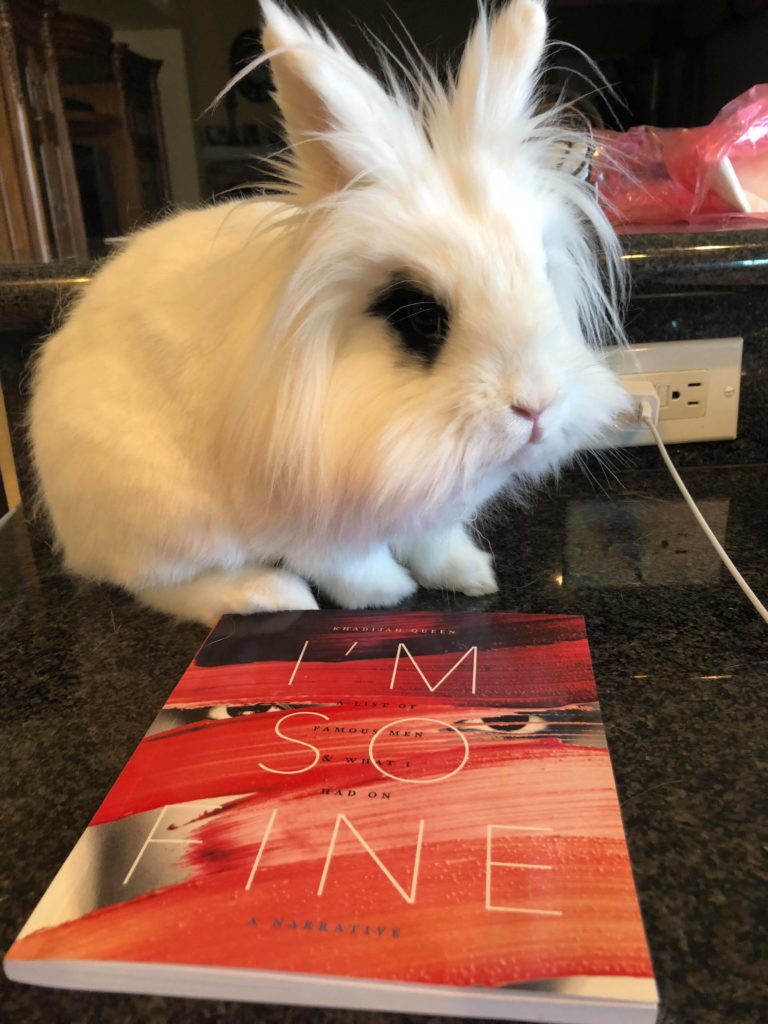The Magnificent Self, in Khadijah Queen’s “I’m So Fine”

There’s something about run-on sentences. When we speak out loud, we are required to pause for air– even debaters, like me, who are trained to double-breathe between speed reading at an average of 350 words-per-minute. A person can’t speak at an unbroken rate forever. But we can think without stopping; in fact, it seems that most of the time, we have no choice. It’s noteworthy when something makes a mind grind to an unnatural halt: a cliche for a reason. And that’s maybe why the run-on sentence is such a staple of prose poetry, and why that sentence form in particular seems to capture the unceasing, associative and break-neck pace of the conscious mind as it runs forwards and backwards through memory.
The memory and the run-on are the core of Khadijah Queen‘s narrative style, all through her collection of poetry-meets-autobiographical-memoir I’m So Fine: A List of Famous Men & What I Had On. The quality of her prose is best described as “organic,” for as I explained above, the constant “&” symbols that lace together her recollections and thoughts in single, breathless sentences are the mimetic of mind. Very soon, graduate students will flock to write psychoanalytical feminist critical treatises about this work, I’m sure; if Luce Irigaray gets a hold of Queen’s book, it will probably be the most inevitable marriage since that of Heaven and Hell. But the really striking part to me is how the book seems to be explaining its meaning to itself. The conversation manifests like a dialogue between the narrator and the narrator, not the narrator and the audience. There’s something feminist about even that, for in a world of surveillance, wherein the female subject is especially well-watched, the gesture of refusing to acknowledge the spectators is counter-cultural, almost defiant. But this defiance is inward, aimed at interiority–so I feel it is misleading to call it “rebellious.” Queen’s work is about loneliness as much as it celebrates the self. And in this contradiction, the narrator meditates upon the complex but oh-so-human reflex to be understood by others and also self-defined.

In the post-script, Queen acknowledges, “Maybe I have to marry myself” (pg 69). In a less mature writer, the split-impulse resolved by means of paradox might seem tired, or at least overly-clever. But Queen’s usage is layered, and variable, and resonant because the rest of the book prefigures its coming. We watch the narrator through her childhood, teens and adult years as she fends off unwanted advances, lusts after fine men, and candidly sizes herself up time and time again. These assessments usually come as she describes her outfit–a way of looking back on herself in time that is anchored in details of personal fashion. “I’m sure I looked a hot poor mess but oh well” (pg 22), she notes as she recalls a meeting with LL Cool J at Fatburger. Each poem in the series features a celebrity encounter between the narrator (or family member or friend of the narrator) and a person-of-public-interest (or Optimus Prime, in one instance), and a description of the narrator’s clothing. These motifs interact thematically, for being “seen” and one’s public appearance are obviously keystones in Queen’s greater narrative scheme. Beyond that, both clothing and the rotating circus of celebrities always denote the era, sometimes down to the year. “Dating” herself is a pun that syncs nicely with marrying herself, and perhaps is also the indicator of the a-chronological plot strategy, or the slick observation that both the narrator and her world are in certain ways the products of the times. But my interpretation is that Queen’s impulse has more to do with identity, and the way context impacts her understanding of herself in different time periods. However we may choose to read it, by the time we come to the post-script, the notion of “self” in terms of the narrator is both undeniably singular, and fragmented by moments in time. Her “P.S.” use of full-stop sentences rather than run-ons indicates analysis, commentary, rather than raw memory. We’ve seen enough by then to know the narrator’s voice by a range that spans her entire life up to the present, and also to wonder along with her if that range can ever really be consolidated into a singular notion of self, or only joined uneasily together on a string of memory.
The most striking thing about Queen’s recollections is the self awareness with which she treats them. Even as the form imitates the branching quality of thought-life, Queen passes nothing off as supposedly “unmediated.” The narrator is both object and subject of each episode, and the back-and-forth goes beyond mere reflection, for though the work is a-chronological, it is also progressive. More than halfway through the book, the narrator recalls: “…I was 36 and so NYC in a black turtleneck and salt-and-pepper curls & just starting not to be sad or afraid” (pg 43). This is her response to Edward Norton telling her she is “gorgeous.” There is development though the journey is asymptotic–approaching but never touching the singular self, but always towards awareness, security, and unflinching acceptance of her experiences and how they have shaped her. It is not easy to gaze upon the self in the mirror, nor is the self the same image at every moment, or even between two separate moments. But it does not necessarily follow that the self is not singular, a chain that is always culminating, moving closer to the curve but never at a finite distance. And Queen embraces curves, and stretch marks, and her own face in the way that it is seen by the rest of the world, as she charts this world with personal landmarks and maps out her own space. Frankly, by the end, it is her world, and celebrities just walk in it.
—Kelly Eisenbrand
Share